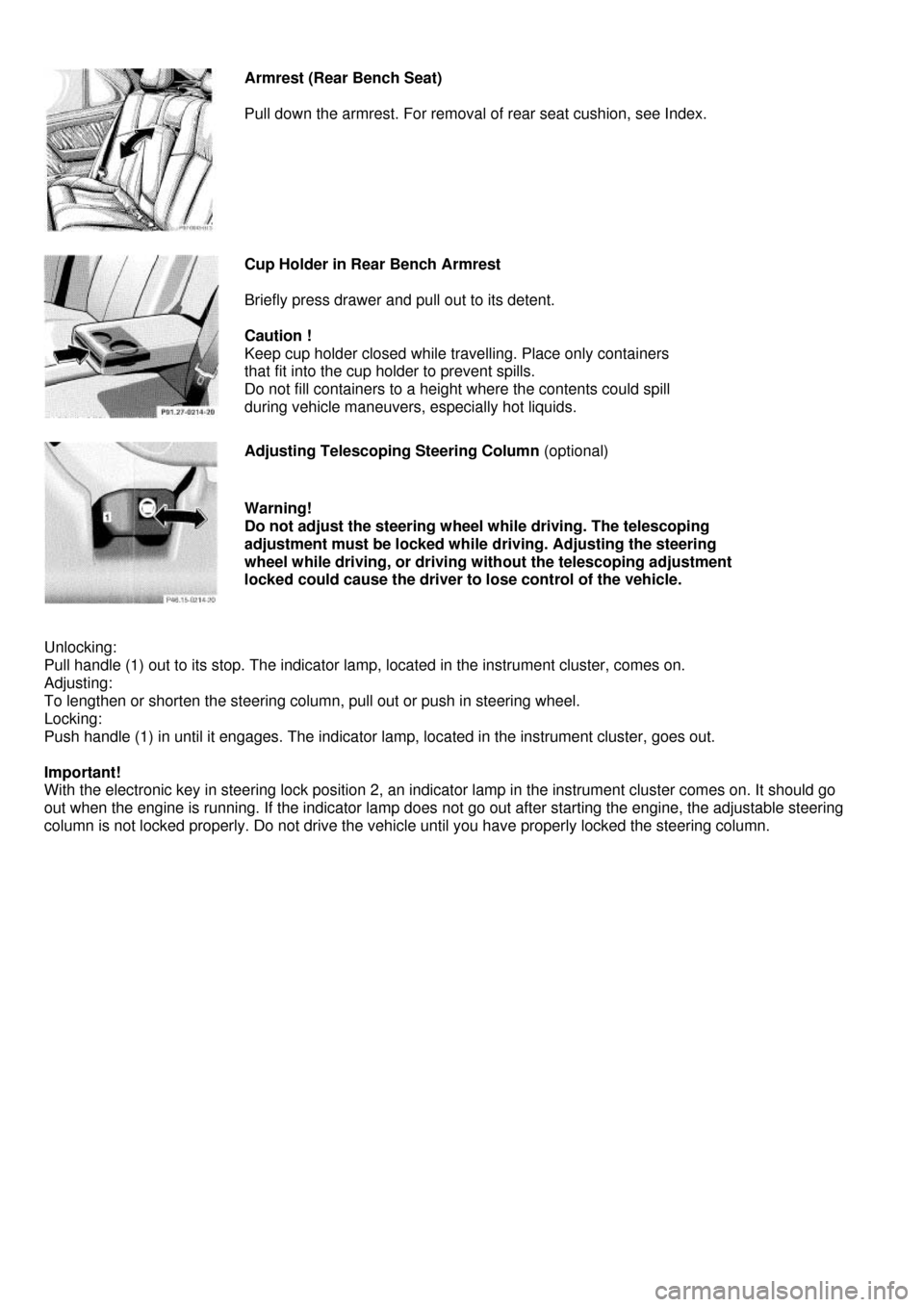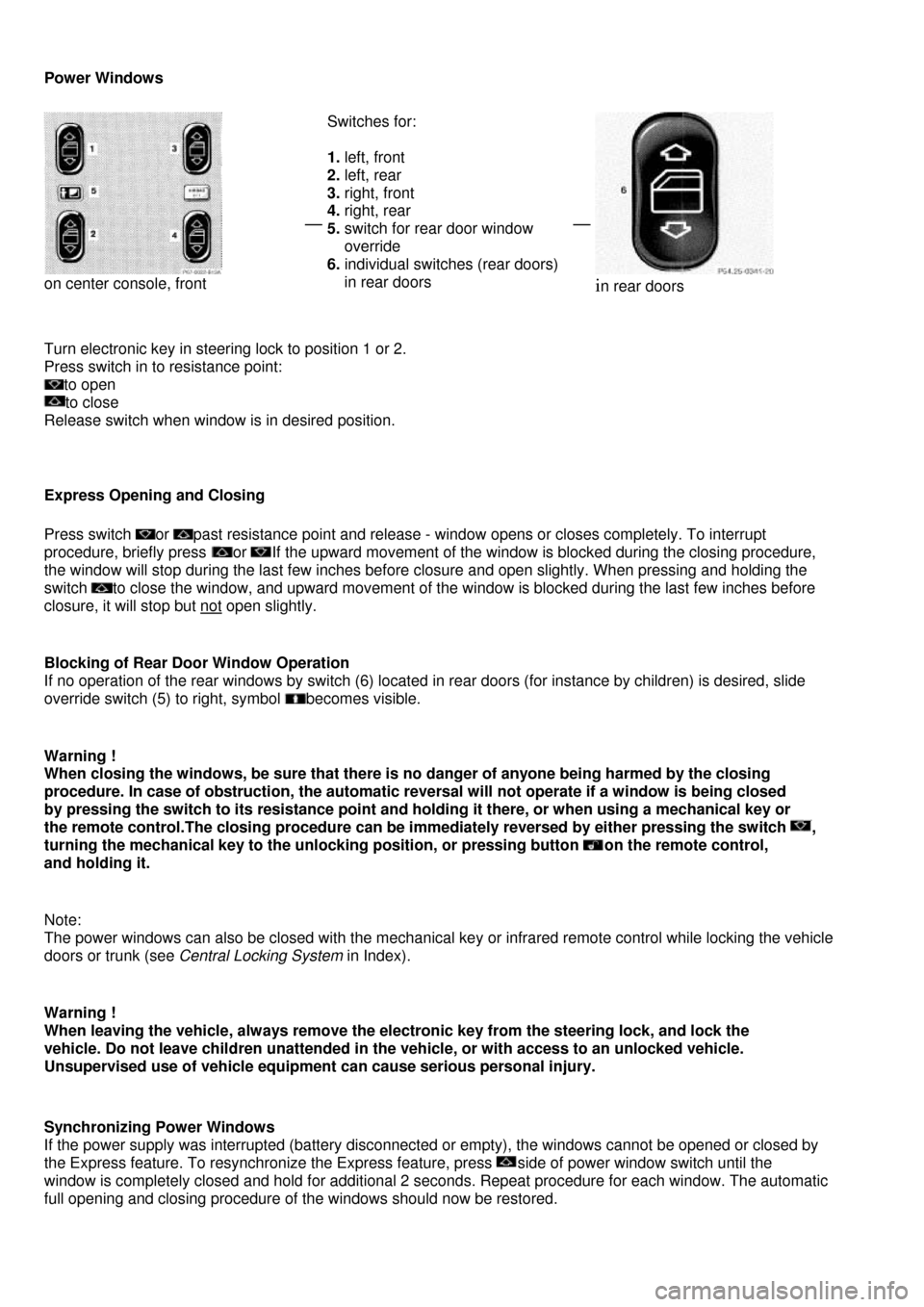control arm MERCEDES-BENZ C-Class 2000 W202 Owner's Manual
[x] Cancel search | Manufacturer: MERCEDES-BENZ, Model Year: 2000, Model line: C-Class, Model: MERCEDES-BENZ C-Class 2000 W202Pages: 130, PDF Size: 2.43 MB
Page 3 of 130

Instruments and Controls
For more detailed descriptions see Index.
For adjustments of air outlets, refer to Automatic
Climate Control (see Index).
1. Side air outlet, adjustable
2. Air volume control for side air outlet
3. Exterior lamp switch
4. Parking brake release
5. Hood lock release
6. Parking brake pedal
7. Steering wheel adjustment lever
8. Combination switch
9. Cruise control switch
10. Horn, airbag
11. Instrument cluster
12. Steering lock with ignition/starter switch
13. Center air outlets, adjustable
14. Air volume control for center air outlets
15. Glove box (illuminated with electronic
key in steering lock position 1 or 2)
16. Left front seat heater switch
17. ASR or ESP control switch
18. Switch for rear seat head restraints
19. Hazard warning flasher switch
20. Central locking switch,
21. Switch for Tow-Away Protection
Indicator lamp for antitheft alarm system
22. Right front seat heater switch
23. Climate control (C 230)
Automatic climate control (C 280,
C43 AMG)
Rear window defroster switch
24. Audio system
25. Open storage compartment
26. Ashtray with lighter
27. Storage/eyeglasses compartment
28. Power window switches, front doors
29. Power window safety switch, rear doors
30. Airbag off indicator lamp
31. Power window switches, rear doors
32. Trunk lid release switch
33. Mirror adjustment switch
Page 23 of 130

Opening the Trunk
A minimum height clearance of 5.9 ft ( 1.8 m) is required to open the trunk lid.
Press transmit button until trunk lid is open.
Important !
Do not place remote control in trunk since trunk is locked again when closing the lid.
Note:
If the trunk was previously locked separately, it will remain locked (see Index).
Opening and Closing Windows and Sliding/Pop-Up Roof from Outside
Aim transmitter eye (5) of remote control at door receivers (6 or 7).
To open:
Continue to press transmit button after unlocking car
The windows and sliding/pop-up roof begin to open after approx. 1 second. To interrupt opening
procedure, release button.
To close:
Continue to press transmit button after locking car
The windows and sliding/pop-up roof begin to close after approx. 1 second. To interrupt closing
procedure, release button.
Warning !
Never operate the windows or sliding/pop-up roof if there is the possibility of anyone being
harmed by the opening or closing procedure.
In case the procedure causes potential danger, the procedure can be immediately halted by
releasing the remote control button. To reverse direction of movement press for opening
or for closing.
Note:
If the windows and sliding/ pop-up roof cannot be operated automatically by pressing the transmit
button of the remote control then it may be necessary to change the batteries in the transmitter
(if ok, battery check lamp in transmitter will light briefly when transmitting), or to synchronize the
electronic main key, see Synchronizing remote Control in Index.
Page 29 of 130

Antitheft Alarm System
1. Indicator lamp in switch located in center console
The antitheft alarm is automatically armed or disarmed with the remote
control or any of your vehicle's mechanical keys by locking or unlocking the driver's door or the trunk.
A blinking lamp (1) indicates that the alarm is armed.
Operation
Once the alarm system has been armed, the exterior vehicle lamps will flash and the horn will sound
intermittently when someone:
• opens a door,
• opens the trunk,
• opens the hood,
• attempts to raise the vehicle.
The alarm will last approximately 21/2 minutes in the form of blinking exterior lamps. At the same time an alarm will
sound for 30 seconds.
The alarm will stay on even if the activating element (a door, for example) is immediately closed.
Note:
We recommend that you carry the electronic reserve key with mechanical key with you and keep it in a safe place
(e.g. your wallet) so that it is always handy. Never leave the electronic reserve key in the vehicle.
Page 30 of 130

Tow-Away Protection
1. Press to switch off.
2. Indicator lamp
The switch is located in the center console.
Once the alarm system has been armed, the exterior vehicle lamps will flash and an alarm will sound when someone
attempts to raise the vehicle. The alarm will last approximately 21/2 minutes in the form of flashing exterior lamps.
At the same time an alarm will sound for 30 seconds. The alarm will stay on even if the vehicle is immediately
lowered.
To prevent triggering the alarm, switch off the tow-away protection before towing the vehicle, or when parking on a
surface subject to movement, such as a ferry or auto train.
To do so, turn electronic key in steering lock to position 1 or 0, or remove electronic key from steering lock. Press
tow-away protection switch (1). The indicator lamp (2) illuminates briefly. Exit vehicle, and lock vehicle with
mechanical key or remote control.
The tow-away protection remains switched off until the vehicle is locked again with mechanical key or remote control.
Page 35 of 130

Armrest (Rear Bench Seat)
Pull down the armrest. For removal of rear seat cushion, see Index.
Cup Holder in Rear Bench Armrest
Briefly press drawer and pull out to its detent.
Caution !
Keep cup holder closed while travelling. Place only containers
that fit into the cup holder to prevent spills.
Do not fill containers to a height where the contents could spill
during vehicle maneuvers, especially hot liquids.
Adjusting Telescoping Steering Column (optional)
Warning!
Do not adjust the steering wheel while driving. The telescoping
adjustment must be locked while driving. Adjusting the steering
wheel while driving, or driving without the telescoping adjustment
locked could cause the driver to lose control of the vehicle.
Unlocking:
Pull handle (1) out to its stop. The indicator lamp, located in the instrument cluster, comes on.
Adjusting:
To lengthen or shorten the steering column, pull out or push in steering wheel.
Locking:
Push handle (1) in until it engages. The indicator lamp, located in the instrument cluster, goes out.
Important!
With the electronic key in steering lock position 2, an indicator lamp in the instrument cluster comes on. It should go
out when the engine is running. If the indicator lamp does not go out after starting the engine, the adjustable steering
column is not locked properly. Do not drive the vehicle until you have properly locked the steering column.
Page 44 of 130

Important !
The "SRS" airbags are designed to activate only in certain frontal (front airbags) impacts, or side (side
airbags) impacts. Only during these types of impacts, if of sufficient severity to meet the deployment
thresholds, will they provide their supplemental protection. The driver and passenger should always wear the
seat belts, otherwise it is not possible for the airbags to provide their intended supplemental protection. In
cases of other frontal impacts, angled impacts, roll-overs, other side impacts, rear collisions, or other
accidents without sufficient forces, the airbag will not be activated. The driver and passengers will then be
protected by the fastened seat belts. We caution you not to rely on the presence of an airbag in order to
avoid wearing your seat belt. The "SRS" is designed to re duce the potential of injury in certain frontal (front
airbags) impacts, and side (side impact airbags) impacts which may cause significant injuries, however, no
system available today can totally eliminate injuries and fatalities.
The activation of the "SRS" temporarily releases a small amount of dust from the airbags. This dust,
however, is neither injurious to your health, nor does it indicate a fire in the vehicle. The service life of the
airbags extends to the date indicated on the label located on the driverside door latch post. To provide
continued reliability after that date, they should be inspected by an authorized Mer cedes-Benz dealer at that
time and replaced when necessary.
Your vehicle was originally equippend with a Suppleme ntal Restraint system (SRS). The SRS airbags are
designet to activate in centrain impacts exceeding a preset treshold to reduce the potential and severity of
injury.merzedes-Benz encourages you to replace deploy ed airbags and repair any malfunktioning airbags to
ensure the vehicle will continue to provid e maximum crash protections for occupants.
Warning!
It is very important for your safety to always be in a properly seated position and to wear your seat belt.
For maximum protection in the event of a collision always be in normal seated position with your back
against
the backrest. Fasten your seat belt and ensure that it is properly positioned on the body. Since the airbag
inflates with considerable speed and force, a proper seating and hands on steering wheel position will help
to keep you in a safe distance from the airbag:
• Sit properly belted in an upright position with your back against the seat back.
• Adjust the driver seat as far as possible rearward , still permitting proper operation of vehicle controls.
• Do not lean with your head or chest close to the steering wheel or dashboard.
• Keep hands on the outside of steering wheel rim. Placing hands and arms inside the rim can increase the
risk and potential severity of hand/arm injury when the driver front airbag inflates.
• Adjust the front passenger seat rearward as far as possible from the dashboard when the seat is occupied.
• Children 12 years old and under must never ride in
the front seat, except in a Mercedes-Benz authorized BabySmart™ compatible child seat, which operates
with the BabySmart™ system installed in the vehicle to deactivate the passenger side front airbag when it
is properly installed. Otherwise they will be struck by the airbag when it inflates in a crash.
If this happens, serious or fatal injury will result . Failure to follow these instructions can result in severe
injuries to you or other occupants.
Safety Guidelines for the Seat Belt, Emergency Tensioning Retractor and Airbag
Warning !
• Damaged belts or belts that were highly stressed in an accident must be replaced and their anchoring
points must also be checked. Use only belts installed or supplied by an authorized Mercedes-Benz dealer.
• Do not pass belts over sharp edges.
• Do not make any modification that could change the effectiveness of the belts.
• The "SRS" is designed to function on a one-time-only b asis. An airbag or emergency tensioning retractor
(ETR) that was activated must be replaced.
• No modifications of any kind may be made to any components or wiring of the "SRS". This includes
the installation of additional trim material, ba dges etc. over the steering wheel hub, front passenger
airbag cover, or front door trim panels, and in stallation of additional electrical/electronic equipment on
or near "SRS" components and wiring. Keep area between airbags and occupants free of objects
( e.g. packages purses, umbrellas, etc.).
• An airbag system component within the steering wheel gets hot
after the airbag has inflated.
• Improper work on the system, including incorrect
installation and removal, can lead to possible injury
through an uncontrolled activation of the "SRS".
• In addition, through improper work there is the risk of rendering the "SRS" inoperative. Work on the
"SRS" must therefore only be performed by an authorized Mercedes-Benz dealer
• When scrapping the airbag unit or emergency tensioning retractor, it is mandatory to follow our safety
instructions. These instructions are av ailable at your authorized Merzedes-Benz
• Depending on the considerable deployment speed and the textile structure of the airbags, there is the
possibility of light skin abrasions.
Page 60 of 130

Sliding/Pop-Up Roof (optional)
1. to slide roof open
2. to slide roof closed
3. to raise roof at rear
4. to lower roof at rear
Turn electronic key in steering lock to position 1 or 2. The switch is illuminated when the
exterior lamps are switched on (except standing lamps). With the roof closed or tilted open,
a screen can be slid into the roof opening to guard against sun rays. When sliding the roof
open, the screen will also retract.
Warning !
When closing the sliding/ pop-up roof, be sure that there
is no clanger of anyone being harmed by the closing
procedure. The closing procedure can be immediately
reversed by either moving the switch in direction
(1) or (3), turning the mechanical key to the unlocking
position, or pressing button on the remote control,
and holding it.
Notes:
The sliding/pop-up roof can be opened or closed manually should an electrical malfunction occur,
refer to Sliding/Pop-Up Roof, Emergency Operation in Index. The sliding/pop-up roof can also be
closed with the mechanical key or infrared remote control while locking the vehicle doors or trunk
(see Central Locking System in Index).
Synchronizing Sliding/Pop-Up Roof
If the power supply was interrupted (battery disconnected or empty), or if the sliding/pop-up roof is
blocked during closing/opening procedure, the system has to be synchronized. To do so, turn electronic
key in steering lock to position 2, move and hold switch in direction (3) until the sliding/pop-up roof is
completely raised at rear, and hold for additional 1 second.
Page 61 of 130

Power Windows
on center console, front
Switches for:
1. left, front
2. left, rear
3. right, front
4. right, rear
5. switch for rear door window
override
6. individual switches (rear doors)
in rear doors
in rear doors
Turn electronic key in steering lock to position 1 or 2.
Press switch in to resistance point:
to open
to close
Release switch when window is in desired position.
Express Opening and Closing
Press switch or past resistance point and release - window opens or closes completely. To interrupt
procedure, briefly press or If the upward movement of the window is blocked during the closing procedure,
the window will stop during the last few inches before closure and open slightly. When pressing and holding the
switch to close the window, and upward movement of the window is blocked during the last few inches before
closure, it will stop but not open slightly.
Blocking of Rear Door Window Operation
If no operation of the rear windows by switch (6) located in rear doors (for instance by children) is desired, slide
override switch (5) to right, symbol becomes visible.
Warning !
When closing the windows, be sure that there is no danger of anyone being harmed by the closing
procedure. In case of obstruction, the automatic reversal will not operate if a window is being closed
by pressing the switch to its resistance point and holding it there, or when using a mechanical key or
the remote control.The closing procedure can be immediately reversed by either pressing the switch ,
turning the mechanical key to the unlocking position, or pressing button on the remote control,
and holding it.
Note:
The power windows can also be closed with the mechanical key or infrared remote control while locking the vehicle
doors or trunk (see Central Locking System in Index).
Warning !
When leaving the vehicle, always remove the electronic key from the steering lock, and lock the
vehicle. Do not leave children unattended in the vehicle, or with access to an unlocked vehicle.
Unsupervised use of vehicle equipment can cause serious personal injury.
Synchronizing Power Windows
If the power supply was interrupted (battery disconnected or empty), the windows cannot be opened or closed by
the Express feature. To resynchronize the Express feature, press side of power window switch until the
window is completely closed and hold for additional 2 seconds. Repeat procedure for each window. The automatic
full opening and closing procedure of the windows should now be restored.
Page 64 of 130

Garage Door Opener
1. Integrated remote control transmitter
2. Portable remote control transmitter
Warning !
When programming a garage door opener, the door moves up or down. When programming or operating
the remote control make sure there is no possibility of anyone being harmed by the moving door.
The built-in remote control is capable of operating up to three separately controlled objects.
Notes:
Certain types of garage door openers are incompatible with the integrated opener. If you should experience
difficulties
with programming the transmitter, contact your authorized Mercedes-Benz dealer or call Mercedes-Benz Customer
Assistance Center (in the U.S.A. only) at 1-800-FOR-MERCedes. For operation in the USA only:
This devise complies with Part 15 of the FCC Rules. Operation is subject to the following two conditions:
(1) This device may not cause harmful interference, and (2) this device must accept any interference received,
including interference that may cause undesired operation. Any unauthorized modification to this device could void
the user's
authority to operate the equipment.
Programming or reprogramming the integrated remote control:
1. Turn electronic key in steering lock to position 1 or 2.
2. Press and hold one button of the integrated remote control located on the sun visor until its control light begins to
flash at a
rate of about once a second. Continue holding down the button.
Note:
The light blinks immediately if the integrated remote control is being programmed
for the first time, or if its memory was previously erased. If you
are reprogramming a previously used button, the light will flash after
about 20 seconds.
3. Aim portable remote control transmitter at the integrated remote control transmitter to be programmed. While still
holding down the button on the transmitter on the inside rear view mirror, press down the button on you r portable
remote control transmitter, until the integrated remote control light starts to flash rapidly. This means that the
integrated transmitter has accepted the frequency and code of the portable transmitter.
4. If you wish, repeat the procedure for each remaining button.
Note:
If the garage door opener is equipped with the "rolling code feature", it needs to be trained to accept the remote
control
command. To do so, the assistance of a second person is required.
1. Locate training button (part of the opener unit in the garage).
2. Press and hold training button until training light next to the button begins to flash (in two seconds).
3. Now have the second person press and hold the previously programmed button on the integrated remote control
transmitter until the training light on the garage door opener is lit continuously (in two seconds).
4. Release and press the programmed button on the integrated remote control transmitter once again to turn off
the training light in the garage door opener.
5. Confirm the garage door operation by pressing the programmed button on the integrated remote control
transmitter.
Page 69 of 130

Important !
Coasting the vehicle, or driving for any other reason with selector lever in "N" can result in transmission damage
that is not covered by the Mercedes-Benz Limited Warranty.
D - The transmission automatically upshifts through 5th gear. Position "D" provides optimum driving characteristics
under all normal operating conditions.
4 - Upshift through 4th gear only.
Suitable for performance driving. To shift from position "D" to "4", push selector lever to the left.
3 - Upshift through 3rd gear only.
Suitable for moderately steep hill s. Since the transmission does not shift hi gher than 3rd gear, this gear selection
will allow use of the engine's braking power downhill.
2 - Upshift through 2nd gear only.
For driving in mountainous regions or under extreme operating conditions. This gear selection will allow use of the
engine's braking power when descending steep grades.
1 - In this position, the engine's braking effect is utilized by shifting into 1st gear.
Use this position while descending very steep or l engthy downgrades and only at speeds below 40 mph (60
km/h).
Important !
With selector lever in position "D", "4" or "3", upshifting from 1st to 2nd to 3rd gear is delayed depending on vehicle
speed and engine temperature. This allows the catalytic converter to heat up more quickly to operating temperatures.
During the brief warm-up period this delayed upshift and increased engine noise might be perceived as a malfunction.
However, neither the engine nor transmission are negatively affected by this mode of operation.
The delayed upshift is effective with vehicle speeds below 31 mph (50 km/h) at partial throttle and engine
temperatures below 95°F (35°C). To avoid overrevving the engi ne when the selector lever is moved to a lower driving
range, the transmission will not shift to a lower gear, if the engine's speed limit would be exceeded. In this case there
will be no downshift, even when the vehicle speed reaches t he engine's speed limit of that gear, e.g. by applying the
service brakes. Continue driving in the usual manner. The transmission will then shift down automatically.
To prevent the engine from laboring at low RPM when driv ing uphill gradients or with your vehicle heavily loaded, the
automatic transmission will downshift when necessary to maintain engine RPM within the best torque range.
Warning!
On slippery road surfaces, never downshift in order to obtain braking action. This could result in drive wheel
slip and reduced vehicle control. Your vehicle's AB S will not prevent this type of loss of control.
Warning !
On slippery road surfaces, never downshift in order to obtain braking action. This could result in rear
wheel slip and reduced vehicle control. Your vehicle' s ABS will not prevent this type of loss of control.
Maneuvering
To maneuver in tight areas, e.g. when pulling into a parki ng space, control the vehicle speed by gradually releasing
the
brakes. Accelerate gently and never abruptly step on the ac celerator. To rock a vehicle out of soft ground (mud or
snow),
alternately shift from forward to revers e, while applying slight partial throttle. Rocking a vehicle free in this manner
may
cause the ABS malfunction indicator lamp to come on. Turn off and restart the engine to clear the malfunction
indication.
Stopping
For brief stops, e.g. at traffic lights, leave the transmission in gear and hold vehicle with the service brake. For longer
stops with the engine idling, shift into "N" or "P" and hold the vehicle with the service brake. When stopping the
vehicle
on an uphill gradient, do not hold it with the accelerator, use the brake. This avoids unnecessary transmission heat
build up.
Warning !
Getting out of your vehicle with the selector lever not fully engaged in position "P" is dangerous. Also,
when parked on an incline, position "P" alone may not prevent your vehicle from moving, possibly hitting
people or objects. Always set the parking brake in a ddition to shifting to position "P". When parked on
an incline, also turn front wheel against curb.